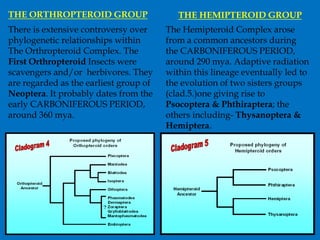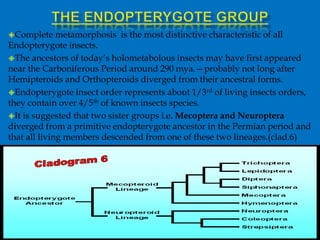Describe the Evolutioary History of Insects
This trend in insect evolution has continued up to the present time to such an extent that 90 percent of the existing orders includ ing 97 percent of the species are now neopterous. Insects are well known to modern-day humans from the generally reviled cockroaches and mosquitoes to the beautiful butterflies and aerodynamic dragonflies.

Evolutionary History Of Insects
David Grimaldi - American Museum of Natural History Michael S.

. Their living diversity relationships and 400 million years of fossils. However particularly as a result of the gargantuan effort of the 1KITE 1000 Insect Transcriptome Evolution consortium the last decade has witnessed an explosion of genome-scale datasets. Atmospheric oxygen is the single most limiting factor for.
Natural history Life cycle Egg. It is divided into six periods of time and the last two saw the development of the largest insects. Insects are known to be evolved from a group of crustaceans.
Trilobita Chelicerata And Mandibulata. The most recent understanding of the evolution of insects is based on studies of the following branches of science. The insect fossil record extends back some 400 million years to the lower DevonianThe Pterygotes winged forms underwent a major radiation in the Carboniferous.
Boudreauxs classification scheme excludes onychophorans because they lack a true exoskeleton but other workers disagree. ORIGIN AND EVOLUTION OF THE INSECTS By Dr. It is estimated that the class of insects originated on Earth about 480 million years ago in the Ordovician at about the same time terrestria.
The study a collaboration of more than 100 scientists from 16 countries as part of the 1000 Insect Transcriptome Evolution project looked at the evolutionary history of insects. David Grimaldi - American Museum of Natural History Michael S. The paleopterous insects which had been dominant during the Carboniferous and Permian began to wane and the N eoptera to flour ish.
The Endopterygota underwent a another major radiation in the Permian. The chorion or eggshell is commonly pierced by respiratory openings that lead to an air-filled meshwork inside the shellFor some insects eg cockroaches and mantids a batch of eggs is cemented together to form an egg packet or ootheca. Fasulo University of Florida Gainesville Florida USA It is impossible to list the number of times insects affected the course of history mostly because historians and physicians during much of our history were not aware that many of the diseases that caused such loss of human life were transmitted by insects.
To discover previously unknown opsins and their evolutionary history in the visual system of an. This is an ambitious book which sets out to describe the evolutionary history of the most diverse group of macro-organism on the planet the insects. The monophyletic classification scheme proposed by BOUDREAUX recognizes three evolutionary lineages within the Phylum Arthropod.
Engel - University of Kansas. Newly molted Odonate alongside its larval skin. The Paleozoic era occurred 542 to 250 million years ago.
An international team of more than 100 researchers has published the first modern roadmap of insect evolution. EVOLUTION OF THE INSECTS Insects are the most diverse group of organisms to appear in the 3-billion-year history of life on Earth and the most ecologically dominant animals on land. There are something like 400000 described species of insects and the total number existing in the world has been variously estimated at.
Insect Evolution of Insects. Full PDF Package Download Full PDF Package. FELT STATE ENTOMOLOGIST ALBANY N.
Define ametabolous hemimetabolous and holometabolous and the similar terms regarding wing development. It was the troubling complexity of reconstructing insect evolution that led the influential German entomologist Willi Hennig 19131976 to lay the foundation of modern phylogenetic systematics igniting a revolution whose consequences reached far beyond the realm of insect science. Evolution of the Insects.
For example insect morphology molecular biology evolution bioinformatics insect taxonomy and scientific computing. Insects affect our lives in many ways. Evolution of the Insects.
These were known as the Carboniferous period 360 to 300 million years ago and the Permian period 300 to 250 million years ago. This book chronicles for the first time the complete evolutionary history of insects. Understanding how insects are related uncovers their true ecological economic and.
Engel - University of Kansas. 3 Introduction Beetle fossil Hemipteran fossil You may wonder. IEFORE attempting a discussion of the subject it may be well to obtain a somewhat clear idea of what is mvolved.
The first molecular phylogeny of insects was published in 1989 and relied on just a single gene marker for twelve species 7. First insects were land bound in the time of Devonian period. HISTORY AND INSECTS Thomas R.
Class of insect originated an earth 400 years ago the same time as terrestrial plants appeared. Quizlet flashcards activities and. And ecological variety insect phylogenetics has been plagued by controversy.
Some circulates in an open cavity. Excluding bacteria insects represent more than half of the worlds biodiversity and are thus considered to be the most evolutionary successful group. In it the researchers describe a novel method for isolating light-sensitive proteins found in the eyes of insects called opsins and detailing their molecular history structure and function to determine what colors an insect can see.
Describe the four successive stages of insect evolution. Insects from Latin insectum are pancrustacean hexapod invertebrates of the class InsectaThey are the largest group within the arthropod phylumInsects have a chitinous exoskeleton a three-part body head thorax and abdomen three pairs of jointed legs compound eyes and one pair of antennaeTheir blood is not totally contained in vessels. Insects are of immense ecological economic and medical importance and affect our daily lives from pollinating our crops to vectoring transmitting diseases said Dr Misof.
Most insects begin their lives as fertilized eggs. Insects may pass unfavourable seasons in the egg stage. Natural History of Insects Midterm 1 study guide by zoe_zahnle includes 77 questions covering vocabulary terms and more.
Describe the theories of insect wing evolution. Molecular biology insect morphology paleontology insect taxonomy evolution embryology bioinformatics and scientific computing. Just as the Paleozoic is often called the age of the trilobite modern time is often called the age of the insect.
Knowing the history of insect evolution also helps us understand their impact on our present-day ecosystems and the natural resources that they support and threaten.

Insect Insect Fossil Record Britannica

Evolutionary History Of Insects


No comments for "Describe the Evolutioary History of Insects"
Post a Comment